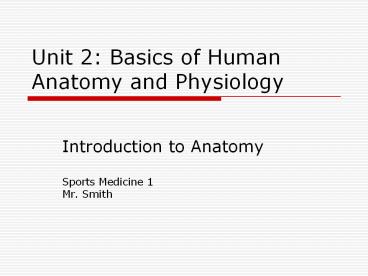Unit 2: Basics of Human Anatomy and Physiology - PowerPoint PPT Presentation
Title:
Unit 2: Basics of Human Anatomy and Physiology
Description:
Unit 2: Basics of Human Anatomy and Physiology Introduction to Anatomy Sports Medicine 1 Mr. Smith Lesson Objectives Describe the functions of skin, bone, muscle ... – PowerPoint PPT presentation
Number of Views:323
Avg rating:3.0/5.0
Title: Unit 2: Basics of Human Anatomy and Physiology
1
Unit 2 Basics of Human Anatomy and Physiology
- Introduction to Anatomy
- Sports Medicine 1
- Mr. Smith
2
Lesson Objectives
- Describe the functions of skin, bone, muscle,
ligament, tendon, and cartilage - Describe the types of bones and identify examples
- Describe the classification of joints and explain
the types of motion produced - Label general muscular and bony anatomy
3
Body Tissues
- Skin
- Most superficial layer
- First line defense against external forces
- Keeps bodily fluids in
- Picks up sensations
- Secrets an oily substance
4
Body Tissues cont
- Skin
- Made up of several layers
- Superficial epidermis
- Middle- dermis
- Deep- hypodermis or subcutaneous layer
- Stores about 50 of bodys fat
5
Body Tissues cont
- Skin
- Has ability to expand
- Accommodate increases in muscle girth or fatty
tissue - Stretch marks are where the dermis was stretched
excessively until elastic fibers ruptured
6
Body Tissues cont
- Bones
- Protect vital organs and structures from trauma
- Are stiff structures that are acted on by muscles
to create movement - Are metabolically active that is, produced blood
cells and store minerals such as calcium and
phosphorus - Protect nerves and blood vessels that travel
alongside them
7
Body Tissues cont
- Bones
- Approximately 206 bones in body
- Axial Skeleton
- Spine, thorax, skull
- Appendicular Skeleton
- Extremities
8
Body Tissues cont.
- Epiphysis (growth plate)
- Spongy during adolescence and can be problematic
because of vulnerability to injury - Diaphysis
- Shaft of the bone
9
Body Tissues cont
- Articular Cartilage
- Cushions bone ends, provides stability with
movement - Periosteum
- Supportive sheath that provides nutrient blood
for the bones - Spongy Bone
- Filled with either red or yellow bone marrow,
capable of making changes according to weight,
postural change and muscle tension
10
Body Tissues cont
- Compact Bone
- Dense bone
- Medullary Cavity
- Cavity of diaphysis, contains marrow
- Red Marrow
- Composed of red and white blood cells. In adults
it is limited to the sternum, vertebrae, ribs,
hips, clavicles, and cranial bones - Yellow Marrow
- Fatty connective tissue, replaces red marrow in
the epiphysis, medullary cavity of long bone, and
cancellous bone of other bones
11
Body Tissues cont
- Bones
- Long Bones
- Short
- Flat
- Irregular
- Sesamoid
12
Body Tissues cont.
- Long Bones
- Having a body which is longer than it is wide
with growth plates (epiphysis)
13
Body Tissues cont
- Bones
- Long Bones
- Femur
- Tibia
- Fibula
- Humerus
- Radius
- Ulna
14
Body Tissues cont.
- Mini Long Bones
- Metacarpals
- Metatarsals
- Phalanges
15
Body Tissues cont.
- Short Bones
- Carpals
- Wrist Bones
- Tarsals
- Foot Bones
- A bone that is as wide as they are long
16
Body Tissues cont.
- Flat
- They are as they sound, flat plates of bone
- Scapula (Shoulder Blade)
- Sternum (Breast Bone)
- Cranium (Skull)
- Pelvis
- Ribs
17
Body Tissues cont.
- Irregular
- Bones that do not fall into any other category,
due to their non-uniform shape - Vertebrae (Bones of the Spine)
- Sacrum (Tail Bone)
- Mandible (Lower Jaw)
18
Body Tissues cont.
- Sesamoid
- Usually short or irregular bones, imbedded in a
tendon - Often a so called Floating Bone
- Patella (Knee Cap) Most Known
- 2 Small Bones at base of 1st Metatarsal
- Sometimes 1 at base of Thumb
19
Body Tissues cont
- Cartilage
- Functions to join structures
- Absorb shock
- And permit smooth bone movement
20
Body Tissues cont
- Muscle
- Allows the body to accelerate, decelerate, stop
movement, and help to maintain normal postural
alignment - Tendon
- Attach muscle to bone and transmit the force that
a muscle exerts - Ligament
- Connect bone to bone and helps to form joints
21
Body Tissues cont
- Connective tissue
- Made up of spindle-shaped cells that support and
bind together other tissues - Ligaments and Tendons
22
Classification of Joints
- Diarthrodial (synovial)
- Really good mobility
- Consist of a joint capsule, synovial membrane,
hyaline cartilage - Hinge Joint
- Elbow and Knee
- Multiaxial or Ball and Socket Joint
- Hip and Shoulder
- Most mobility of all joints
23
Classification of Joints
- Amphiarthrodial Joints
- Cartilage attaching two bones together
- Ribs join the Sternum
- Synarthrodial
- Held together by tough connective tissue, and are
basically immoveable - Bones of the Skull

